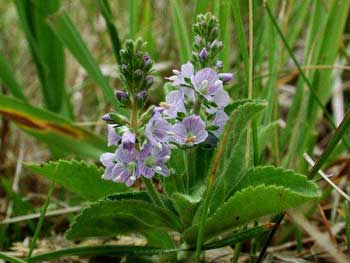Contents:
Common Names | Parts Usually Used | Plant(s) & Culture | Where Found | Medicinal Properties | Biochemical Information
Legends, Myths and Stories | Uses | Formulas or Dosages | Warning | Bibliography
Scientific Names

- Veronica officinalis L.
- Scrophulariaceae
- Figwort family
Common Names
- Figwort
- Fluellin
- Ground-hele
- Gypsy weed
- Low speedwell
- Paul’s betony
- Upland speedwell
- Veronica
Parts Usually Used
The flowering plant, leaves, root
Back to Top
Description of Plant(s) and Culture
Speedwell is a small perennial plant; the creeping, woody, hairy stem sends up branches from 3 to 10 inches high and is rooted at the joints. The opposite, oblong, grayish-green leaves are soft and have finely toothed margins. The light blue flowers have violet streaks and grow in dense, axillary, spikelike racemes from May to August. The fruit is an obovate, compressed, hairy capsule.
Another variety: Thyme-leaved speedwell (V. serpyllifolia); leaf juice used by Native Americans for earaches; leaves poulticed for boils; tea used for chills and coughs.
Back to Top
Where Found
Found in dry meadows, waste places, fields, and woods over the eastern half of North America, as far south as North Carolina and Tennessee.
Back to Top
Medicinal Properties
Alterative, diuretic, expectorant, stomachic, tonic
Back to Top
Biochemical Information
Aucubin
Back to Top
Legends, Myths and Stories
Similar in flavor to Chinese green tea, Speedwell tea is a common tea in Europe and is, in fact, known there as The` de l’Europe.
Of the 20 or so Veronica species that occur in North America, almost all are naturalized weeds from Europe and Asia. They are often found growing on lawns in the United States. Most species have blue veins on violet-blue flowers, and a whitish center.
Back to Top
Uses
A tonic, used in cough, catarrh, asthma, lung diseases, kidney ailments, rheumatism, jaundice, promotes sweating, urination, and menses, and for skin diseases. Primarily used as an expectorant in respiratory problems. Used for stomach ailments, migraine headaches, and as a gargle for mouth and sore throat sores. The fresh juice is taken in large quantities for gout, and it can be used externally to relieve chronic skin problems.
Back to Top
Formulas or Dosages
Infusion: steep 2 tsp. flowering herb in 1/2 cup boiling water. Take 1 to 1 1/2 cups a day, a mouthful at a time.
Juice: take 2 tsp. in water or milk, 3 times a day.
Back to Top
Warning
One component, aucubin, though liver-protective, anti-oxidant, and antiseptic, can be toxic in grazing animals.
Back to Top
Bibliography
![]() American Folk Medicine
American Folk Medicine, by Clarence Meyer, Meyerbooks, publisher, PO Box 427, Glenwood, Illinois 60425, 1973
![]() Eastern/Central Medicinal Plants
Eastern/Central Medicinal Plants, by Steven Foster and James A. Duke., Houghton Mifflin Company, 215 Park Avenue South, New York, NY 10000
![]() The Herbalist Almanac
The Herbalist Almanac, by Clarence Meyer, Meyerbooks, publisher, PO Box 427, Glenwood, Illinois 60425, copyright 1988, fifth printing, 1994
![]() The Herb Book
The Herb Book, by John Lust, Bantam Books, 666 Fifth Avenue, New York, NY. copyright 1974.
Herbal Gardening, compiled by The Robison York State Herb Garden, Cornell Plantations, Matthaei Botanical Gardens of the University of Michigan, University of California Botanical Garden, Berkeley., Pantheon Books, Knopf Publishing Group, New York, 1994, first edition
![]() Webster’s New World Dictionary
Webster’s New World Dictionary, Third College Edition, Victoria Neufeldt, Editor in Chief, New World Dictionaries: A Division of Simon & Schuster, Inc., 15 Columbus Circle, New York, NY 10023
 The Rodale Herb Book: How to Use, Grow, and Buy Nature’s Miracle Plants (An Organic gardening and farming book)
The Rodale Herb Book: How to Use, Grow, and Buy Nature’s Miracle Plants (An Organic gardening and farming book), edited by William H. Hylton, Rodale Press, Inc. Emmaus, PA, 18049., 1974
